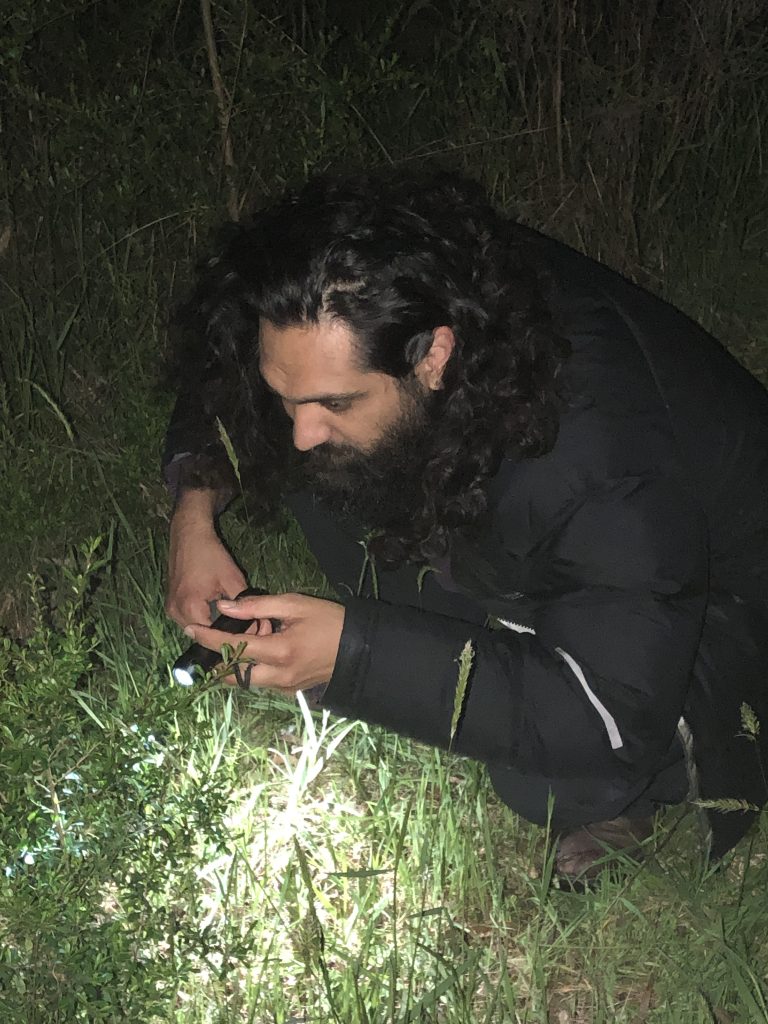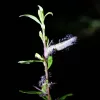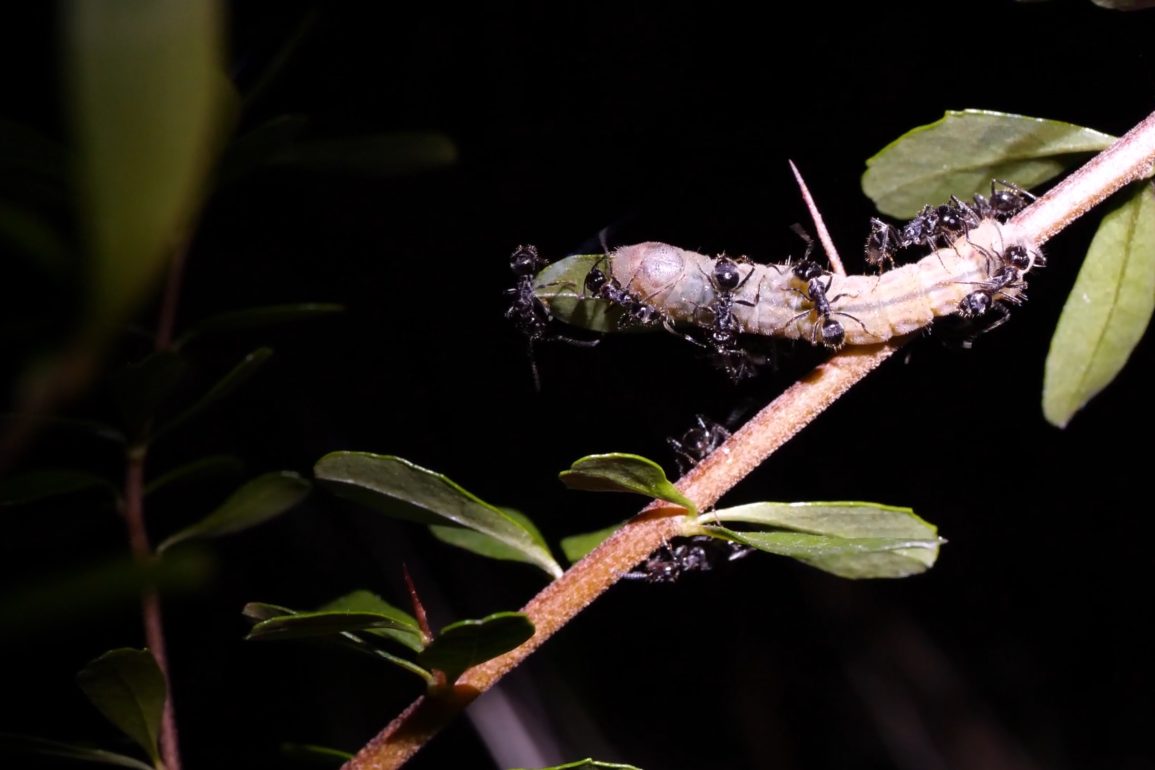Eltham is the named home to the Eltham Copper Butterfly (Paralucia pyridiscus lucida), an endemic species known to be found in only a few small areas in Victoria. It is small in size – 25mm to 27mm – with bright copper-orange colour on the top of its wings, which are fringed with brown. It was first discovered in 1938, and then was not seen for many years. The butterfly was considered extinct until it was rediscovered in 1986.
In Victoria, small populations are found in Eltham, Greensborough, Castlemaine and Bendigo, as well as a tiny population in Kiata. Eltham Copper Butterflies can typically be seen in flight in December and January.
From December to March, the butterfly lays eggs in branches and leaves of the sweet bursaria (Bursaria spinosa) shrub, choosing the smaller shrubs where ant species within the genus Notoncus are present. After several weeks of incubation, the eggs hatch and a white caterpillar emerges.
The caterpillars are nocturnal and spend the daylight hours underground in Notoncus ant nests at the base of their sweet bursaria bush, where the ants guard them from predators such as birds. During the night, the caterpillars emerge to feed on the bush’s leaves. At this time, ants are frequently seen near or on the caterpillars. They feed on the sugar secretions from the caterpillars. This arrangement with the caterpillar, ants and bush is symbiotic – all parties benefit.
In springtime, the caterpillars gain weight in preparation for their pupation by creating a chrysalis in the ground. After several weeks, the caterpillars metamorphose to emerge as butterflies. This can happen as early as late November, but mostly occurs in December. A second emergence often takes place in March. Generally it is easier to see the males, which frequently travel in flight circles around their home bush. Females often hide in bushes, trying to avoid male attention.
Eltham-Greensborough is the population centre for the Eltham Copper Butterfly. Nillumbik Shire owns and manages five bushland reserves, Parks Victoria one reserve, Yarra Valley Water one colony and four are in private ownership. Recently, it has been confirmed that there is an additional population in the school grounds of Eltham East Primary School. (See article in the Nov-22 edition of CopperLine).

The five main shire reserves and the Yarra Valley Water land cover only 7.79 hectares – a minute speck of properties in Eltham protecting this endangered butterfly. They are:
- Western Colony, owned by the shire, 0.75 ha
- Eastern Colony, owned by the shire, 1.12 ha
- Yarra Valley Water Diosma Road Reserve (managed by the Shire) 0.71 ha
- Woodridge Linear Reserve, owned by the shire, 0.11ha
- Pitt Street Reserve, owned by the shire, 0.25 ha
- Hohnes Hill Reserve, owned by the shire, , 4.85 ha
- The Pauline Toner Reserve, owned by Parks Victoria,
The Pauline Toner Reserve and Hohnes Hill Reserve have public walking trails.
Urbanisation and agriculture as well as activities such as slashing, vegetation clearing and inappropriate fire regimens have contributed to the loss of native bushlands and, consequently, a dramatic decline in butterfly numbers compared to their status prior to colonisation.
Eltham has a strong conservation program to protect the Eltham Copper Butterfly, which is classified as an endangered species under Commonwealth and state legislation. Conservation work has been ongoing for nearly 40 years. Nillumbik Shire works with the Eltham Copper Butterfly Working Group, auspiced by the Arthur Rylah Institute, to inform its conservation program. In 2012, the state government provided a $459,000 grant for enhancement and protection of Eltham Copper Butterfly habitat. Recently Nillumbik Shire Council received a further $240,000 grant from the federal government to continue conservation management and protection work.
Nicole Drever, a shire environmental works officer, says: “It is an absolute privilege to work with the community and ecologists to enhance and conserve the remaining critical habitat for the iconic Eltham Copper Butterfly”.
Nicole works with butterfly biologists in Bendigo and Castlemaine, pooling their work experiences for a better understanding of the butterfly’s biology and management practices.

Annual population counts of caterpillars have been made since the late 1990s. The population declined significantly during the early 2000s, apparently owing to an overabundance of non-food shrubs in the reserves. The use of grant funds seems to have stabilised the populations. While 2022 population counts are still in progress, there appear to be several hundred Eltham Copper Butterflies across the main reserves.
On 19 October, 2022, a team of 16 volunteers led by Council’s contractors, Wildlife Experiences, conducted a night-time survey of caterpillars at Hohnes Hill Reserve after the butterfly was spotted in 2021. This survey discovered nine caterpillars scattered across two locations. These observations were an encouraging sign that this reserve is capable of supporting a viable population of Eltham Copper Butterflies.
Entomologists are still learning more about the Eltham Copper Butterfly. Many, including Andrea Canzano, have been conducting research for the past 30 years and have discovered much about its life cycle and habits.

Friends groups play a crucial role in protecting the reserves and supporting the monitoring and counting of populations of caterpillars and adults. Wayne Kinrade, convener of the Friends of the Eltham Copper Butterfly, said: “The Eltham Copper Butterfly is a flagship species. Its survival is dependent on us protecting the delicate ecosystems where they live. We can all get involved in protecting this important species while also learning how to better protect the rich biodiversity of the shire.”
Eltham residents can join the friends organisation and make significant contributions as citizen scientists volunteering and working to manage butterfly habitat.
In 2023, the Friends of the Eltham Copper Butterfly will be conducting monthly working bees across several of the reserves. Details will be available from the Council website and the Eltham Copper Butterfly Facebook page.
You can help the Copper Butterfly conservation efforts by joining Friends of the Copper Butterfly. Please contact Wayne Kinrade by email: [email protected].





